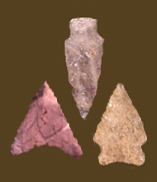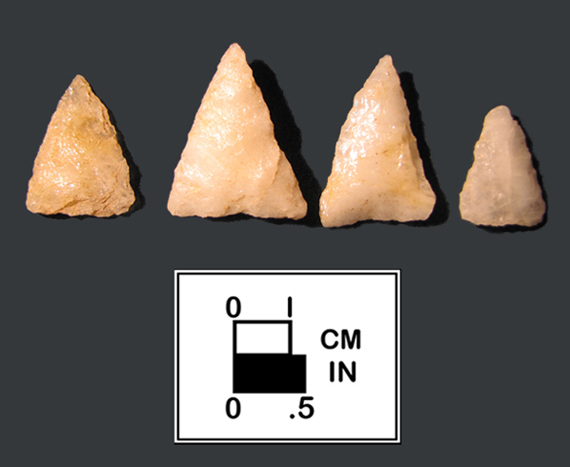
ARCHAIC TRIANGULAR POINTS Traditionally, triangular projectile points in Maryland have been associated with the use of the bow-and-arrow during the Late Woodland period (although they probably served other functions as well). But there is clear stratigraphic evidence from a number of sites in the Northeast that triangles also occur in far earlier contexts. Some of these triangle-shaped points would never be confused with the Late Woodland examples. The Morrow Mountain Triangle from Tennessee is much larger than the later points, and the trianguloid points reported from Paleoindian sites such as Turkey Swamp exhibit significant morphological differences (Lindstrom and Stevenson 1987; Cavallo 1981). The Brewerton Eared Notched and Brewerton Eared Triangle points are similar to the Late Woodland points in size, but are readily distinguished by shallow side notches. Ritchie (1971) published two small Late Archaic triangular point types: the Beekman Triangle of New York, and the Squibnocket Triangle of southern New England and eastern New York. The two types overlapped chronologically and morphologically, with the primary distinguishing trait being the absence of basal grinding on Squibnockets. Wingerson and Wingerson (1974) described a third triangular type, the Hunterbrook. This equilateral point has excurvate sides and a ground and thinned base. At the Hunter Brook Rockshelter near the Hudson River, it was found below Beekman Triangular points. Dates for Archaic period triangular points in the Northeast range from 8500 to 3000 BP, but most fall between 5600 and 4100 BP (Katz 2000). Middle and Late Archaic triangles have been found at a number of locations in the Delaware Valley, particularly at the deeply stratified sites in and around the Abbott Farm National Historic Landmark, where they were recovered from contexts possibly as old as 6500 BP (Lothrop and Koldehoff 1994; Wall et al. 1996; Bello et al. 1998; Miller 1998; Stewart 1998). A similar date range is seen at Susquehanna River sites. For example, at the West Water Street site, an equilateral point with a convex base was found with LeCroy points, while site 36LY290 produced a triangle associated with several radiocarbon dates around 5600 BP (Custer et al. 1994; Miller 1998; Katz 2000). In Maryland, a Beekman Triangle was recovered from a Late Archaic context at the Higgins site in Anne Arundel County (Ebright 1992). More recently, another Anne Arundel site, Pig Point, has produced a number of triangles in stratified Archaic contexts associated with Otter Creek and Piscataway points (Luckenbach et al. 2010; Luckenbach 2014, personal communication). The Late Woodland and Archaic triangles at Pig Point are visually indistinguishable (Luckenbach 2014, personal communication). Researchers looking at other Archaic triangles from the Middle Atlantic region have noted a preference for basal thinning (Custer et al. 1994), or asymmetrical pressure flaking that produced a somewhat beveled base (Wall et al. 1996), but acknowledged that Late Woodland points can share these traits. In a study of 161 Late Woodland and Archaic triangles from three sites, including ones at or near Abbott Farm, Katz (2000) noted that Archaic points were more commonly made from quartz, and had a greater proportion of straight and shallowly concave bases. Archaic triangles also tended to have narrower bases, a smaller percentage with ground bases, a smaller edge angle, and a greater proportion with excurvate lateral edges. Katz also noted some statistical differences in the morphology of earlier and later Archaic points. However, all the metric variables showed considerable overlap, and Katz concluded that it was impossible to distinguish Archaic and Late Woodland triangles at the individual projectile point level in the assemblages he studied. Therefore, identifying Archaic and Late Woodland triangles has to rely heavily on their archaeological context. References Bello et al. 1998; Cavallo 1981; Custer et al. 1994; Ebright 1992; Katz 2000; Lindstrom and Stevenson 1987; Lothrop and Koldehoff 1994; Luckenbach et al. 2010; Miller 1998; Ritchie 1971; Stewart 1998; Wall et al. 1996; Wingerson and Wingerson 1974 |
![]()
Search by Shape:
(See Projectile Point Typology) |

|
Thank you for visiting our website. If you have any
questions, comments, Copyright © 2002 by |

|

